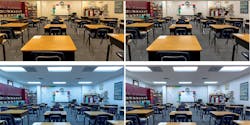Schools Test Tunable LED Lighting
Energy savings are the driving reason behind many LED retrofits, but additional considerations could help make the financial case for a lighting revamp even more appealing. Tunable white LED systems offer the ability to change the color temperature of lighting as needed in addition to the lower energy costs that are possible with all LED lighting. Three classrooms in Carrollton, TX, tested the tunable lighting to determine whether customizable color temperature benefited their classrooms in a DOE-sponsored study.
A fifth-grade math and science classroom, a fourth-grade reading and language arts classroom and an eighth-grade science laboratory were all retrofitted with tunable LED luminaires with a color temperature range of 3000-5000K. The system allowed teachers to use four preset scene controls that would change all luminaires to 3000K for reading, 3500K for testing, 4200K for general use or a 5000K “energy” setting. Teachers could also increase or decrease light output or turn off luminaires in zones for presentations.
Most of the energy savings came from replacing the previous fluorescent system with LED lighting and adding dimming with controls, meaning that the financial case for color-tunable systems can’t be made solely on energy conservation. “The difficulty in documenting and assigning economic value to potential non-energy benefits poses a major challenge for color-tunable lighting systems,” the study explains.
Those additional benefits of the system were significant, however. Two of the three teachers provided detailed feedback about the lighting system, and both noted that students responded positively to the ability to adjust the lighting temperature. The eighth-grade teacher in particular “felt that the tunable lighting system enhanced his ability to engage with the students about the classroom environment,” the study notes. “He would ask for input on the control settings and adjust the lighting.”
Both teachers relied on the “general” setting for most of the class time, especially the fifth-grade teacher, who found it inconvenient to change the controls because existing wiring required the control panel to be installed at the back of her classroom. However, the need to ask students to change the settings for her developed into a way to increase student engagement. “As they grew familiar with the lighting and controls, students would occasionally request certain settings,” the researchers say. “The students also learned to recognize the behavioral clues that the control settings indicated. The dimmed, warm setting became a cue that the teacher expected the class to be in their seats and quiet down.”
Institutional applications like schools or healthcare settings may well derive enough benefit from user-friendly color-tuning to justify investing in such a system. Factoring in user satisfaction and health impacts will go a long way toward making the financial case for tunable lighting.
